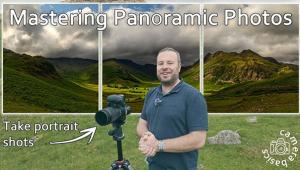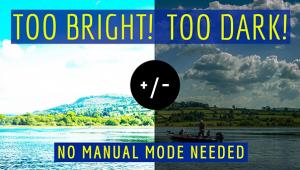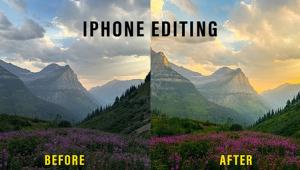Future Report; A Look At What’s Ahead For Photography In 2006…And Beyond
As is our wont, in this issue we asked our contributors to give us their thoughts
on what the future holds, be it gear, technology, or trends in photography.
We received a wide range of opinions, from those proclaiming that film is finally
dead to those who see diversity in image making as important. There's
no doubt that many people still use and enjoy working with film. But there's
no question that at least from the hardware side of our world, that digital
has dominated, and will continue to do so in the future. We haven't seen
a new film 35mm SLR in almost a year now, while we have seen digital SLRs proliferate.
Film and paper coating plants continue to close with Kodak and others reporting
that the decline in film sales has made them opt out of that area quicker than
even they anticipated.
The opinions that follow are from those folks who do know their stuff, and who
work every day with gear and materials and who have an insider's view
on what's happening down the road. I encourage you to read their opinions
both literally and between the lines. They are often tipped off about future
trends but are also sworn to blood oaths to keep a lid on it until the designers
or manufacturers deem it timely to unveil their plans.
That said, here's my two cents:
One area that will be getting increased scrutiny this year is printing and,
by inference, the lifespan of the digital-only image file. While billions of
images will be made with digital cameras, only a small percentage of those will
be printed. But the printed image is a physical manifestation of the image,
while the digital file is, indeed, virtual. Yes, the drumbeat is backup, backup,
and backup again, but by its very nature the digital-only image is ephemeral,
one that is subject to the constancy and reliability of the storage medium,
the format, and even the ability of future imaging programs to read and display
it. Given that the average lifespan of a hard drive, or even an operating system,
is perhaps four years, and given that many folks will not bother to back up,
it's a sure thing that many digital images will be lost to future generations.
True, film images are subject to deterioration, witness the magenta chromes
and faded color negatives sitting in too many file cabinets. But they remain,
to their last gasp, recoverable to a certain extent, ironically often by digital
means. But what remains of my grandparent's photographs, and their parents
before them, is a physical record, a print, regardless of how faded or spotted
it might be. We in all likelihood will not have that privilege in the future
with many digital images made today.
The headlong rush to digital has had many benefits, the main one to me being
the incredible opening of creative doors and the ability of many more people
to experience the pleasure of working with their images beyond the initial pressing
of the shutter release. But as the inevitable crashes and corruption of files
takes place the silence about digital's ephemeral nature will become a
topic worthy of discussion. It's an issue that was more often than not
passed over in the euphoric rush of gear and technology, but one that as photographers
and recorders of memories we should confront and solve.
The best advice I can give is to plan a back-up strategy and stick with it,
and to print those images that are important to you, and that you think will
be important touchstones for future generations. Research the most archival
of papers and inks and support those companies that make an effort to ensure
that those prints will last. And don't abandon film or "traditional"
prints, as it turns out, given their proper processing and storage and given
failure to back up or print digitally originated images, that these may be the
most permanent image records of all. No one suggests that you print every digital
photo, just as you don't save a majority of prints made on film. But making
sure that future generations will have the ability to visually connect with
their past is part of your job as a photographer.
--George Schaub
Portrait Photographer Forecast: Continued Gray Skies Ahead
My forecast last year caused a stir among professional portrait and wedding
photographers, I heard it was cause for many postings on several pro forums.
I was both amused and a little surprised. The cause of the furor was my decidedly
negative outlook on the wedding and portrait market, especially weddings. I
stated that the wedding market was in decline for the lower and middle market
because of digital cameras and the photojournalistic trend that made clients
believe they could do the job themselves. Many portrait clients, especially
high school seniors, also believed they could do the job themselves because
of the acceptance of outdoor portraits and ease of use of digital cameras.
While many pros did not agree with my opinions, I thought I was just reporting
a trend that was already developing, not guessing what lies ahead. As 2006 begins,
I see no reason to change my opinion.
Digital imaging has taken the mystery out of photography. Press a button and
an image appears. It might be garbage, but you know there's an image resting
on that camera card. Good enough!
This has taken two "must-have" event-driven markets and moved them
into the optional category, and given birth to a new adversary. Where we once
had "Uncle Charlie" doing weddings, we now have "Mom the Photographer"
doing portraits. Pick up any high school yearbook without restrictions on the
senior portrait and you'll see what I mean immediately. Using "Mom"
is not solely an economic choice, but a lifestyle statement by those who think
it's not "cool" to go to a studio. I know a family worth over
$300 million who chose "Mom" over a professional.
I base my opinion not only on my observations and talks with New England photographers,
but also photographers around the country. Please note that I predict a great
market for photographers creating unique work, charging a suitable price, and
offering outstanding client service. If this is not you, I believe your days
are numbered.
Is it all gloom and doom? Of course not. Today's photographer must be
proactive and create new "events" and reasons for portraits. Our
"Summer at the Beach" portraits and "Fall Family Portrait"
events are very popular and very profitable. We have also changed our marketing
to focus more on formal studio portraiture, something "Mom" can't
do, and have placed a new emphasis on children's portraiture, a very big
market we previously ignored. We are phasing out weddings anyway, just doing
them for our regular clients, simply because we make much more money on family
portraits in less time and after over 25 years of toiling in the "Satin
Jungle," my heart just is not in it anymore.
I've never really cared what the "photographer down the street"
was doing, I don't base my photography or business on him or her. But
the photographer who ignores trends and doesn't pay attention to what
is happening around them is operating blind. See the light, and prosper!
--Steve Bedell
Better Year For The Serious Enthusiast
Although no one really knows how much the economy will be affected by the recent
hurricanes and other drains on people's budgets, it was evident before
2005 summer's end that digital camera sales were beginning to soften.
This is not unexpected considering the huge growth in digital photography. It
was time for the competition to weed out the weak and dubious, and for the industry
to begin to mature.
To my way of thinking the serious enthusiast may not have to be confused by
as many new toys and the onslaught of forced obsolescence as much, and may very
well have more refined and practically useful digital photography products at
more affordable costs to look forward to. Even if gas prices crimp the budget,
what can be afforded should continue to get better in function and value. And
there is now the chance, instead of just going after the easy sell with the
latest gimmick, manufacturers will take the one area most neglected in the digital
photo rush, the serious enthusiast, more seriously. The market area between
the millions of snapshooters and the high-end professionals may just be the
digital photography industry's best opportunity to maintain and increase
business activity. We might just see the less serious impulse type sales falloff.
In general, we all have to take things a bit more seriously if we want any kind
of future.
--David B. Brooks
Thoughts About Digital Imaging In The Near Future And Beyond
As digital cameras become more and more affordable, and as they boast higher
and higher resolution, the switch to digital capture is certainly compelling.
At one time, the strongest growth was in the compact camera category, but today,
the growth in digital SLR sales is far more dramatic. According to an InfoTrends/CAP
Ventures estimate, the sale of digital SLRs in 2005 increased by 80 percent
over 2004 in North America; this trend is expected to continue for at least
another year. Meanwhile, fewer and fewer photographers are buying 35mm SLR cameras,
but there's no point beating that issue into the ground.
Is the current CCD and CMOS technology perfect? Is it the best that will ever
be available? The answer to both questions is no, at least in my estimation.
As you read this, some engineers are probably working feverishly to invent the
next generation of capture technology for the year 2010. According to my crystal
ball, the cameras will produce much higher resolution at faster framing rates,
beautiful image quality at high ISOs, and instant data recording to an entirely
new type of media. By then, we'll consider today's cameras to be
low tech: dinosaurs, if you will.
In the near future, we'll start seeing an increasing number of digital
SLRs with larger sensors. Canon has already introduced a relatively affordable
model with a full-frame (35.8x23.9mm) CMOS sensor, the 12-megapixel EOS 5D,
but expect to see others, starting in 2006. The primary advantage of a 35mm
size sensor is that it eliminates the 1.6x "focal length magnification
factor" (field of view crop). Consequently, ultra-wide angle photography
is possible without the need for extremely short focal length lenses. Some image
quality benefits are also possible with cameras that boast larger photosites
(pixels) on their oversized sensors. The dynamic range (highlight/shadow detail)
should be wider while the increased sensitivity should produce high ISO images
with less digital noise.
Both of those technical benefits would be even more valuable in digital cameras
with built-in lenses. Typically, such cameras utilize tiny sensors crammed with
millions of microscopically small photosites, producing images with narrow dynamic
range and prominent noise even at a modest ISO 400 setting. Sony has taken the
first step in a new direction that should solve those problems, and other camera
manufacturers are likely to follow.
The new 10-megapixel Cyber-shot DSC-R1 (with built-in 24-120mm zoom) features
a 21.5x14.4mm APS-C size sensor previously used only in digital SLRs. That's
massive: roughly 2.4x wider and 2.2x longer than the largest (8.8x6.6mm) sensor
used in previous prosumer cameras. Naturally, the photosites are also huge:
the pixel pitch (size) has increased from 2.7 micrometers to 5.49 micrometers.
As a result, Sony claims that the DSC-R1 will produce 2.5 times wider dynamic
range and five times higher sensitivity than the earlier Cyber-shot DSC-F828,
while using less battery power.
Although we have not yet tested the DSC-R1, it is likely to produce dramatically
better image quality at high ISO settings. Indeed, the new model offers options
up to an incredible ISO 3200 vs. the more typical maximum of ISO 800. During
2006, several other companies are also likely to introduce prosumer cameras
employing an APS-C size sensor. That will be ideal for anyone who prefers an
ultrahigh-resolution camera with built-in lens over a larger/more expensive
digital SLR system, and they won't need to wait five years because this
future trend is right around the corner.
--Peter K. Burian
Digicam Features
I see more features being built into digicams--stitching images, auto composition
aids, Image Stabilization. All designed to help users go from capture to print
with minimal fuss and no computer time. Wireless support in cameras and printers
should become more common. In digital SLRs I think entry-level prices will continue
to come down with a camera and lens kit in the $600 range. Canon's new
full-frame EOS 5D will be a huge hit at its price point and give Nikon a tough
challenge. Windows Vista will be a hit with digital photographers with improved
color management and native support for image management, including raw files
along with easy sharing of photos and videos.
--Jon Canfield
The Shape Of Things To Come
I think that most people who attempt to absolutely, positively, and with certainty
tell you what 10 years or five years or even next year will bring to our industry
are in serious need of professional help. Oh yeah, we all know, or can guess,
that computers will get smaller, cheaper, more powerful, and faster. That's
a given. The same will happen with digital cameras. More compact lenses with
longer zoom ranges, faster maximum apertures, improved Image Stabilization/
Vibration Reduction, remarkable designs utilizing new lens element designs and
evermore exotic glasses are just around the corner (watch for Shutterbug's
PMA issue coming up in the spring). But except for these very general prognostications
such speculation should probably be taken with a grain of salt. Especially mine.
All the things I mentioned earlier will continue to happen but perhaps at a
somewhat slower pace than we have been experiencing. Digital SLR cameras will
grow in file size while improving handling ease but I'm not sure that
we'll see new cameras as frequently as we have been.
One common concern is whether today's digital file formats will prove
to be tomorrow's 8-track players. For the digital photographer who's
paying attention this is somewhat of a moot point as long as he/she doesn't
get too far behind the
technology curve.
In my classes, and on several websites I frequent, I'm seeing a small
but persistent ground swell of photographers who prefer traditional materials
or, like myself, work in a hybrid analog/digital environment. I suspect we will
see more photographers return to the film fold although traditional materials,
especially black and white, will continue to be harder to find.
As I have stated before, I don't like computers--hate 'em in
fact. But I sure like what you can do with the darn things. Would I go back
to the way things were before Photoshop, camera raw, inkjet printing, et al.?
Not on your life. The ease of processing and control I now have over my images
is pretty heady stuff. Do any of you remember color printing with CP-5 chemistry
on one of those wonderful Kodak processing drums with the room temperature at
105ÞF and a relative humidity of around
100 percent?
If I get nostalgic for the good old days I'll just put on some Firehouse
Five or Turk Murphy and open a cold one.
--Joseph A. Dickerson

































